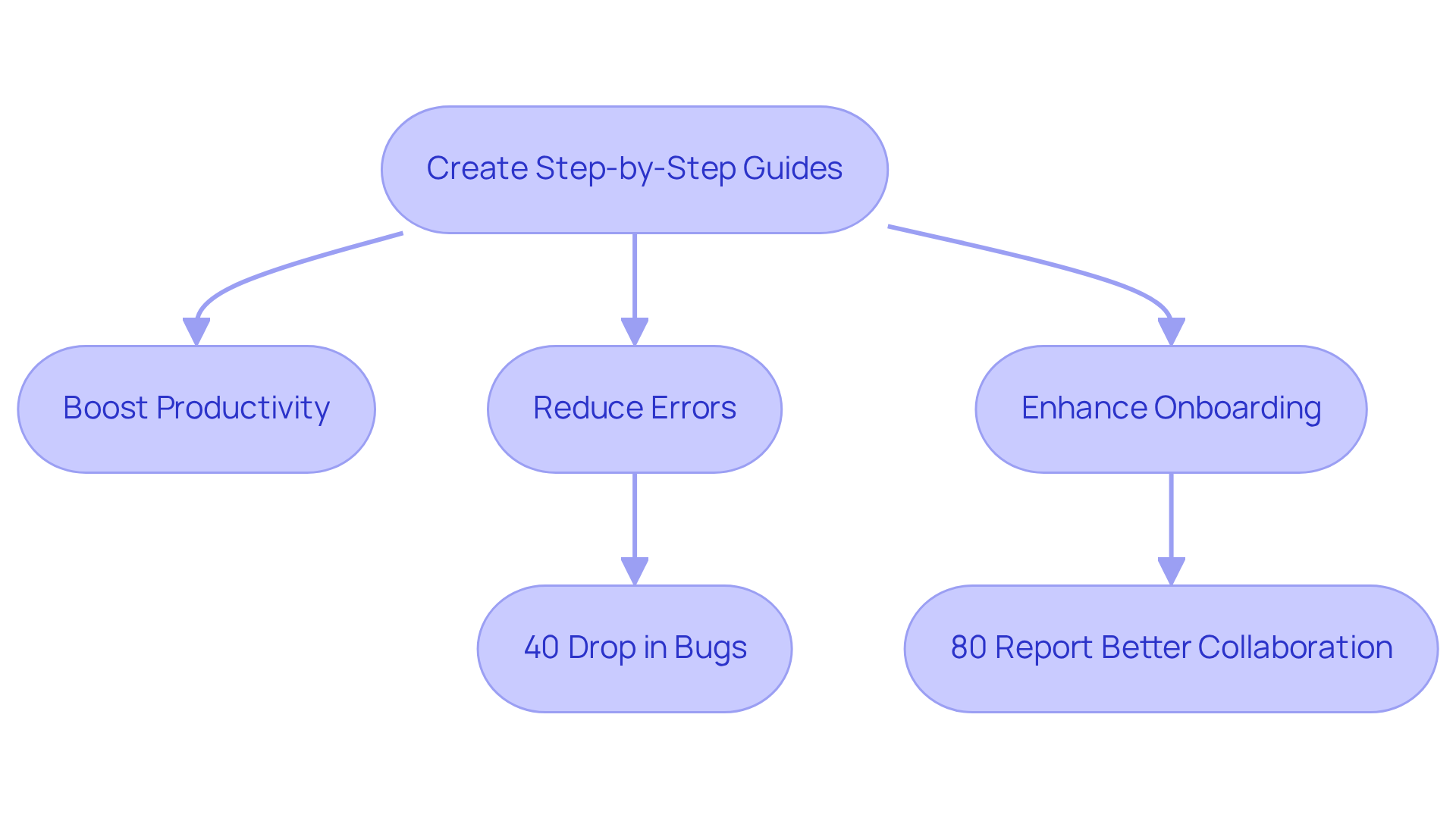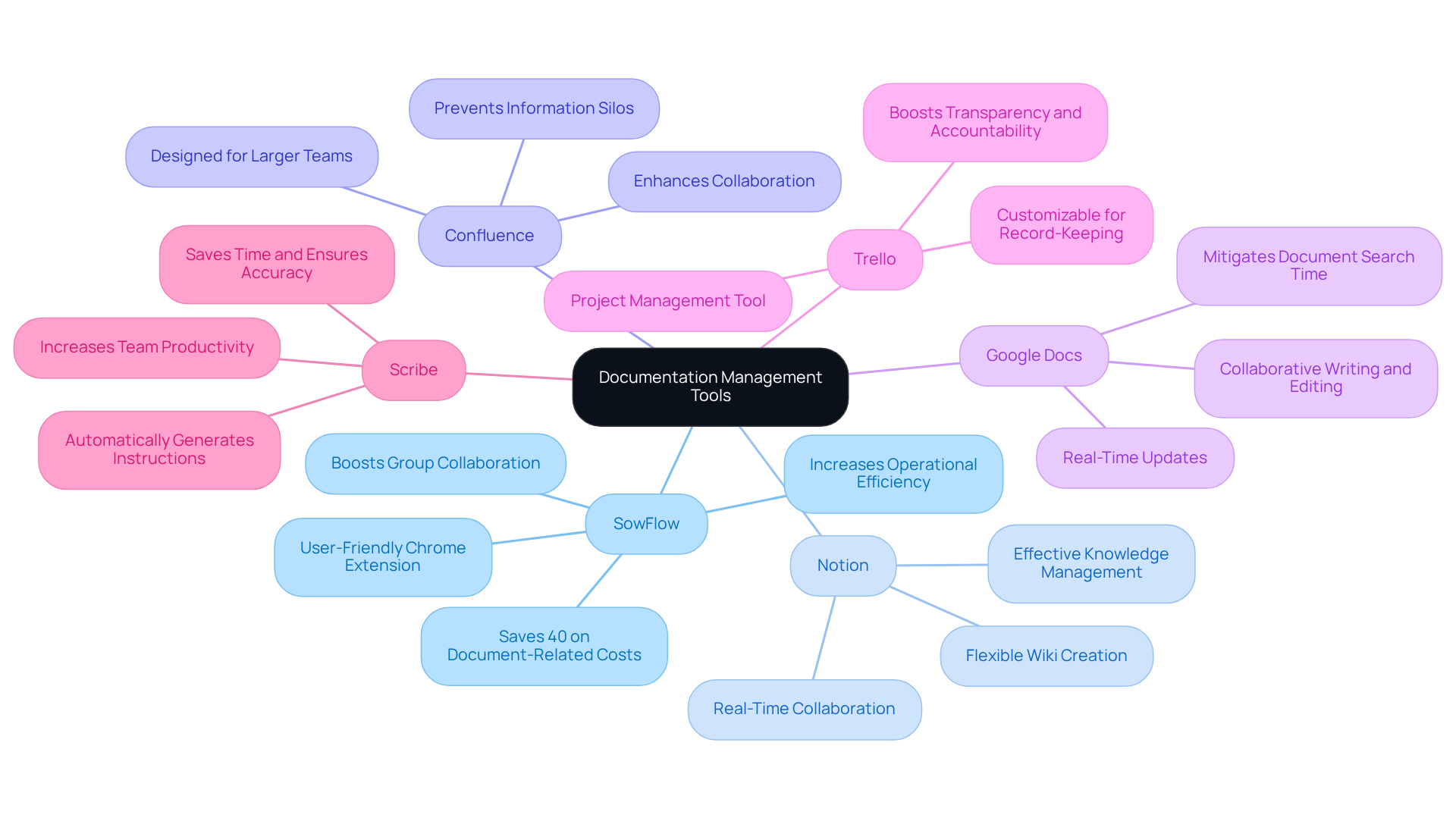
Process Improvement through Documentation
|
October 16, 2025
|
Master Documentation: Create a Site with Step-by-Step Guides
Overview
You might be wondering how to create effective documentation that truly makes a difference. Well, this article dives into just that, offering step-by-step guides that not only enhance productivity but also reduce errors and improve onboarding experiences. It’s all about making your documentation work for you!
Let’s explore some practical strategies for crafting those guides. We’ll highlight the benefits of using tools like SowFlow, which can streamline your process. Plus, we’ll showcase some eye-opening statistics that demonstrate how well-structured documentation can boost organizational efficiency. Sounds good, right? Now, let’s dive into the details and see how you can implement these ideas in your own work!
Key Highlights:
- Step-by-step guides simplify complex processes into manageable tasks, enhancing productivity and knowledge retention.
- SowFlow's documentation solution allows for easy creation of user manuals, keeping them relevant in fast-paced environments.
- Organisations adopting step-by-step guides report a 40% reduction in bugs and errors, improving operational efficiency.
- Effective documentation enhances onboarding experiences, with 80% of teams experiencing better collaboration.
- Creating guides involves defining the purpose, understanding the audience, breaking down tasks, using clear language, and incorporating visuals.
- Testing instructions with users ensures clarity and effectiveness in documentation.
- Key tools for documentation management include SowFlow, Notion, Confluence, Google Docs, Trello, and Scribe, each offering unique benefits.
- Common documentation challenges include outdated information, lack of clarity, inconsistent formatting, difficulty accessing information, and low engagement.
- Regular reviews and a style manual can help maintain document accuracy and consistency.
- Encouraging team involvement in documentation fosters a collaborative culture and improves efficiency.
Introduction
Creating a site with step-by-step guides isn’t just a passing trend; it’s a smart strategy that can really change how organizations handle knowledge and boost productivity. You might be wondering how breaking down complex processes into bite-sized tasks can help. Well, these guides not only make workflows smoother but also encourage a culture of continuous learning and self-service.
But here’s the kicker: how can teams effectively whip up and keep these invaluable resources fresh in such a fast-paced environment? Now, let’s dive into some practical steps and tools that can help you master documentation, ensuring your organization can optimize operations and cut down on errors.
Understand the Importance of Step-by-Step Guides
You might be wondering why sequential instructions matter so much in records. Well, they really help by creating a site with step-by-step guides that break down complex processes into bite-sized tasks. This organized approach not only boosts productivity but also aids in retaining knowledge, making it easier for you to revisit a site with step-by-step guides whenever needed. Now, with SowFlow's instant documentation solution, creating user manuals is a breeze—just one command and you’re good to go! This means your documentation stays relevant, even in a fast-paced business world.
Speaking of relevance, organizations that embrace these practices have seen a whopping 40% drop in bugs and errors. That’s a clear win for optimizing operations! Plus, well-crafted resources on a site with step-by-step guides can significantly enhance the onboarding experience for new hires, helping them settle into their roles quickly and with minimal supervision. In fact, 80% of teams report better collaboration thanks to improved documentation practices. So, by focusing on developing these resources with SowFlow, you can really cultivate a culture of self-service and continuous learning, leading to smoother and more scalable operations. Isn't that something worth exploring further?

Create Your Step-by-Step Guides: A Practical Approach
Creating effective step-by-step guides can be a breeze if you refer to a site with step-by-step guides that outlines these practical steps!
First off, you might be wondering, what’s the purpose? Clearly outlining what your document aims to achieve is key—whether you’re teaching a new software feature or explaining a specific process. This foundational step keeps your resource focused and relevant.
Next, let’s talk about your audience. Who will be using this document? Tailoring the language and complexity based on their familiarity with the topic is essential. You want the content to resonate with their experience level, right?
Now, it’s time to break down the process. Think of dividing the overall task into smaller, manageable steps. Each step should be clear and concise, focusing on one action at a time to make things easier to understand and execute.
And don’t forget to use clear language! Writing in simple, jargon-free terms ensures accessibility. Active voice and direct instructions work wonders here (e.g., ‘Click the button’ instead of ‘The button should be clicked’) to enhance clarity.
Visuals are your friends! Incorporating screenshots, diagrams, or videos can really complement the text. Visual aids significantly boost understanding and retention, making those complex processes a lot easier to navigate.
Before you finalize everything, test those instructions! Have someone unfamiliar with the process give them a go. Collect their feedback and make any necessary tweaks to enhance clarity and effectiveness. This ensures your resource truly meets the needs of its users.
Once you’re all set, it’s time to publish and share! Release the document in a central location where all relevant team members can easily access it. This accessibility is crucial for fostering a culture of knowledge sharing and efficient onboarding.
Successful examples of sequential instructions in companies, highlighted on a site with step-by-step guides, demonstrate how effective they can be in improving client engagement and shortening onboarding durations. For instance, Trello uses visually appealing resources that incorporate icons, colors, and helpful suggestions to engage users effectively. Statistics reveal that organizations with clear records experience shorter onboarding periods, with the average onboarding duration for new corporate clients being around 100 days. By sticking to these optimal methods for creating instructional materials in 2025, teams can develop valuable resources that empower individuals and enhance operations.

Leverage Tools for Efficient Documentation Management
You know, utilizing the right tools can really make a difference in your record management process. So, let’s dive into some recommended tools that could help you out:
- SowFlow: This intuitive resource tool is all about empowering you to create and manage guides effortlessly. With its user-friendly Chrome extension, you can keep records right from your browser, making the whole process smoother and boosting group collaboration. Organizations that use SowFlow have seen a noticeable increase in operational efficiency, with many teams reporting less time spent on record-keeping. In fact, businesses that switch to cloud-based document management systems save an average of 40% on document-related operational costs—talk about a win!
- Notion: If you’re looking for flexibility, Notion is your go-to platform for creating wikis and records. It supports real-time collaboration, which is super important since 46% of employees find it tough to locate the information they need. Tools like Notion can really help with effective knowledge management.
- Confluence: Designed for bigger groups, Confluence packs a punch when it comes to managing records and enhancing collaboration. It makes sure that all team members have access to the latest info, tackling the pesky problem of information silos that can slow down productivity.
- Google Docs: This simple yet powerful tool is perfect for collaborative writing and editing. With Google Docs, multiple users can work on files at the same time, ensuring everyone stays updated in real-time. This capability is crucial, especially since employees spend about two hours a day searching for documents—something that effective collaboration tools can really help mitigate.
- Trello: While Trello is mainly a project management tool, you can easily tweak it for record-keeping by creating boards for different instructions and processes. This approach allows for easy monitoring and modifications, boosting transparency and accountability within teams.
- Scribe: This innovative tool automatically generates step-by-step instructions from workflows, saving you time and ensuring accuracy in your records. By reducing the manual effort needed to create guides, Scribe lets teams focus on what really matters, ultimately ramping up productivity.
By utilizing a site with step-by-step guides, you can simplify your record-keeping methods, enhance group collaboration, and improve overall efficiency. And here’s a fun fact: 85% of companies say that investing in cloud computing technologies is a top goal for the next few years. So, adopting tools like SowFlow isn’t just a good idea—it’s essential for staying competitive!

Troubleshoot Common Documentation Challenges
Documentation can be a bit tricky, can't it? Even with the best intentions, we often run into some common challenges. Let’s chat about these issues and explore some effective strategies to tackle them together:
- Outdated Information: You might be wondering how often you should check your documentation. Regular reviews are a must to keep everything accurate! Setting reminders for periodic updates and encouraging your team to flag outdated content can make a big difference. Did you know that 91% of organizations report data quality problems that mess with their operations? That really highlights the importance of keeping those records fresh! The Archive Corporation points out that "the challenges that companies encounter due to their inefficient document processes result in a 21.3% loss in efficiency." Ouch! Clearly, we need to stay on top of this.
- Lack of Clarity: Have you ever found yourself scratching your head over confusing instructions? If your users are having a tough time, it might be time to rethink the language you’re using. Simplifying instructions and adding some visuals can work wonders for comprehension. A study found that 85% of employees lack confidence in the information they share externally. That just goes to show how crucial clear records are!
- Inconsistent Formatting: So, what’s the deal with formatting? Creating a style manual is a game-changer for keeping everything uniform—think formatting, terminology, and tone across all your materials. Not only does this improve readability, but it also gives a professional vibe that’s essential for effective communication. Plus, 83% of employees struggle with version control, which really underscores the need for a style manual to cut down on confusion.
- Difficulty in Accessing Information: Ever feel like finding the right document is like searching for a needle in a haystack? Organizing your records in a centralized spot with a clear structure is key! Using tags and categories can really streamline the search process, making it a breeze for users to find what they need. Research shows that 48% of employees have a hard time locating documents quickly, so let’s make that easier!
- Low Engagement: Want to boost engagement? Encourage your team to get involved in record-keeping! Fostering an environment where everyone sees record-keeping as a shared responsibility, and recognizing contributions, can really inspire participation. With 46% of small businesses reporting wasted time due to inefficient paper processes, promoting collaborative documentation can lead to some serious efficiency gains. Let’s work together to make documentation a team effort!

Conclusion
You might be wondering why creating a site with step-by-step guides is more than just a trend. Well, it’s actually a fundamental approach to boosting productivity and nurturing a culture of continuous learning in organizations. By breaking down complex processes into bite-sized tasks, these guides empower you to tackle challenges confidently, ensuring that documentation stays relevant and effective in our fast-paced world.
Now, let’s dive into some key arguments for implementing these guides. They can:
- Reduce errors
- Improve onboarding experiences
- Enhance team collaboration
The benefits really are clear! Tools like SowFlow and Notion can make managing documentation a breeze, and with practical strategies for crafting clear, concise instructions, you can totally transform how information is shared and retained. Plus, by regularly updating your documentation and engaging users, you can tackle common challenges and significantly boost the overall quality of your resources.
Ultimately, step-by-step guides are about more than just documentation; they’re vital in shaping user experiences and operational efficiency. Embracing these practices not only leads to better performance but also fosters a proactive environment where knowledge sharing thrives. So, why not explore and invest in effective documentation strategies? It’s a great way to ensure your organization stays competitive and agile in its field!
Frequently Asked Questions
Why are step-by-step guides important in documentation?
Step-by-step guides help break down complex processes into manageable tasks, boosting productivity and aiding knowledge retention.
How does SowFlow enhance the creation of user manuals?
SowFlow's instant documentation solution allows users to create user manuals with just one command, ensuring that documentation remains relevant in a fast-paced business environment.
What impact do step-by-step guides have on bug and error rates?
Organizations that implement step-by-step guides have experienced a 40% reduction in bugs and errors, optimizing their operations.
How do well-crafted resources benefit new hires?
Well-crafted resources enhance the onboarding experience for new hires, helping them settle into their roles quickly and with minimal supervision.
What effect do improved documentation practices have on team collaboration?
Improved documentation practices lead to better collaboration among teams, with 80% of teams reporting enhanced collaboration as a result.
What culture can be cultivated by focusing on step-by-step guides and documentation?
Focusing on developing step-by-step guides can cultivate a culture of self-service and continuous learning, resulting in smoother and more scalable operations.
👍
What others are liking
5 Steps to outline your ideal documentation structure
5 MINS READ
Where to start the your journey of mapping out your ideal documentation structure, aligning it with the very heartbeat of your organization?
Defining a winning level of detail in your process
3 MINS READ
What is too much detail, and what is too little? This article described in that winning level detail about what detail is enough.





